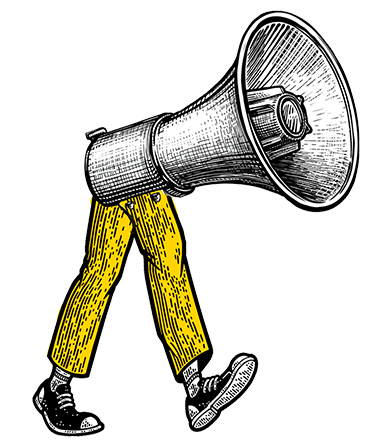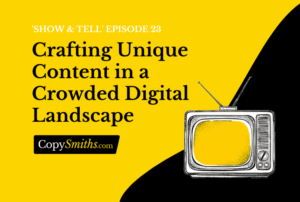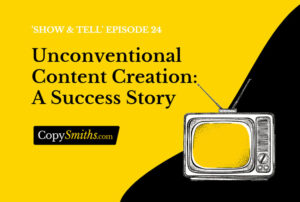Home » Content Marketing » Revolutionary Ideas for Small Business Content Marketing

Revolutionary Ideas for Small Business Content Marketing
Paid advertising works, as evidenced by quarterly reports from Google and Facebook.
With the advent of ad-blockers, however, even heavily boosted and targeted advertisements do not always reach the right customer.
Smaller businesses face several barriers in creating brand awareness and converting potential buyers into paying customers.
Businesses that heavily invest in digital marketing achieve their traction goals, but smaller organisations need to spend smarter and require a better approach when competing with larger counterparts on the same playing field.
Luckily, these barriers are easily overcome in the age of content-driven marketing.
According to this survey, there has been a significant increase in the implementation of small business content marketing strategy from 2019 to 2020, with more businesses declaring higher rates of content marketing success than in previous years.
Statistics show that 90% of all organisations today employ content strategy in their marketing.
While these statistics paint a promising picture, how, exactly, does a small business use content strategy and decide which types of content to adopt?
To answer these questions, let’s first break down the reasons a small business would include content in its marketing strategy.
Why Do Small Businesses Need Content Marketing?
Content marketing is an inexpensive, interpersonal strategy for customer acquisition. It’s preferred by small businesses for the following reasons:
- Cost-effectiveness
- Brand positioning and identity
- Effective customer interaction
Cost-Effectiveness: More Bang for Your Buck
Your business is good at what it does and is solving an identifiable problem within your customer base.
While larger outfits rely on flashy campaigns and enormous funding, it is possible to improve customer perception through subtle but directed business content that demonstrates the value of your product or service.
And the best part is, you don’t need a lot to get going.
According to studies, content generates over three times more leads than outbound marketing, and also costs 62% less.
This is because creating content is easy to get started with, and is more appealing to consumers who have grown weary of traditional targeted advertising.
Brand Positioning and Identity: Communication Is Key
A strong online presence is vital to effectively communicating with potential customers. What most organizations tend to miss out on is that 70% of consumers prefer to learn about a company through articles, as opposed to other types of advertisement.
The overall success of a website and how it converts depend largely on its content.
There is no better marketing tactic than quality, customised business content that resonates with prospective consumers and provides a positive user experience — i.e. content that adds value.
For example, according to this consolidated list, businesses that prioritise blogging experience twice as much email traffic as businesses that don’t, and are 13 times more likely to have a positive ROI on their marketing efforts.
Effective Customer Interaction: Getting Up Close and Personal
Effective content has the unique ability to demonstrate your brand’s identity by taking advantage of the adage, “Show, Don’t Tell.”
Social media platforms like Instagram, Twitter, LinkedIn, and more, are the most direct and effective means of communicating with your consumers.
Content marketing via social media allows your business to promote itself organically, without the invasive marketing traditions of history.
Lacking valuable information concerning services, examples of work in progress, or updates about company success, mass-media-centric advertising was simply not as intimate or informative as modern social media content marketing.
Allowing consumers to willingly subscribe to your social pages, e-mails, or blog leaves little room for saturation with your messaging while also affording the ability to keep updated with the happenings of your business.
This includes social media posts and high-quality content related to special offers, discounts, and more.
To put it simply, customers subscribe to your channels because they want to hear from you.
This follower-centric model of social media marketing strategy allows your brand to define its customer base and communicate relevant, valuable information to them directly.
How Do Businesses Use Content Marketing?
Now that we have discussed the benefits of small business content marketing, let’s get into how businesses use content marketing and the best content strategies to employ.
Great content comes in many formats, with as much room for creativity and innovation. Here’s a list of a few that work well for smaller businesses:
- Blog posts and articles
- Infographics and lists
- Interactive content
- Audio-visual content
Blog Posts and Articles
While consistency is valuable, creating content is a great way for your business to relate to its audience on a level that is comfortable and familiar.
Written content like blogs and articles achieve this end by highlighting universal emotions — like excitement, anger, appreciation, and shock — and by employing viral storytelling tactics to boost views.
As a small business owner, you want to aim for high-quality content with great SEO value that shows customers you understand what they need.
Looking at your service from a customer’s lens helps identify what they are thinking and feeling. This solidifies your position as an industry thought leader, boosting engagement and leading to more conversions.
That being said, high-quality content creation takes time and effort. This is one of the major reasons most organizations outsource content creation — in fact, in B2B companies, 84% of marketers outsource their content creation activities.
If you are looking for an easy way to craft quality, authoritative content to boost your SEO rankings, trust CopySmiths with your needs.
CopySmiths has over two decades of content marketing experience, with a tried-and-tested strategy for success.
Learn more about our services, and get in touch to discover the right content solution for your business.
Infographics and Lists
Do you recall the last time you looked up a company website to learn more and were met with intimidating figures and hard-to-decipher technical language?
Your customer base is intrinsically curious and wants to know more about you. Over-technicality and unapproachability alienate prospective buyers, and are an example of ineffective content.
Communicating big ideas through bite-sized pieces of content — like colorful infographics and well-curated lists — is an effective means of building awareness. Short listicles are among the most-shared content on the internet, increasing brand visibility and familiarity.
Interactive Content
Interactive content employs the foot-in-the-door technique of driving sales, inspiring visitors to action by asking them to do something. While content should always have a call-to-action, truly effective content requires action to be taken.
Interactive tools like forms are popularly used by businesses, but aren’t necessarily the most effective.
However, tools that are tailored to your services — like a tax calculator on a financial website or an interactive map of fertilizer wholesalers on a gardening website — have a higher chance of keeping the consumer engaged by nudging them to think more deeply about their needs, and, by association, how you can help satiate them.
Audio-Visual Content
Content is most effective when it is delivered regularly and consistently. However, it also needs to be available to users where, when, and in the format they want to see it.
With the growing popularity of mobile devices, audio-visual content is at an all-time high with users demonstrating higher degrees of engagement with content that is portable, concise, and engaging to the senses.
Podcasts and videos are popular formats of content used across the globe today, owing to their unique personal and communicative touch.
Distribution entities like Apple Music, YouTube, and Spotify make this content infinitely more accessible to users on-the-go and are armed with the social-sharing capabilities required to boost your reach.
CopySmiths
I'm Katrina McKinnon, founder of CopySmiths and Small Revolution. In my 20 years of experience, I have helped online businesses create high-performing content specifically on an eCommerce store's blog. Find me on LinkedIn and Twitter.

CopySmiths offers the best blog writing services for online stores.
If you'd like us to write blog articles for you, click here.
Most Recent
- 3 Bold Questions You Should Ask When Hiring A Content Writer

- 5 Practical Reasons You Should Use a Blog Post Template

- 4 Amazing Benefits of Using a Title Generator for New eCommerce Blogs

- 10 Awesome Bio Examples Your Online Store Blog Should Emulate

- 8 Basic Steps to Successful Content Development Every Time

Podcasts
Got a question?
Ask our friendly team about our article writing services.
Subscribe to CopyZine
Monthly, hand-picked stories of the best in eCommerce Content.




